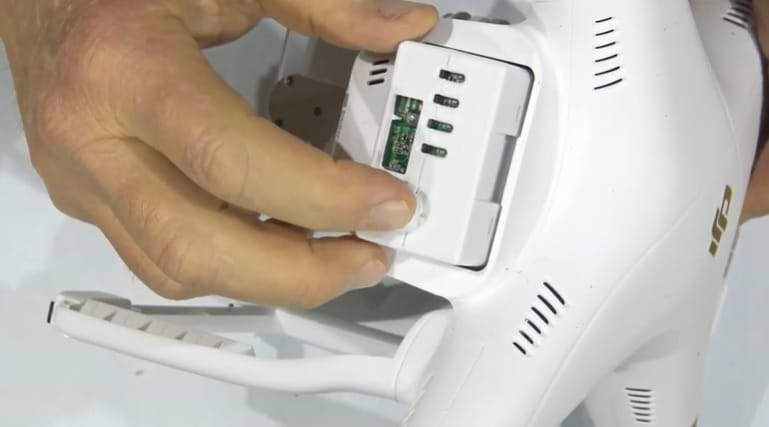
After a nice long flight, I plugged my drone battery into the charger to recharge, aaand nothing. For some reason, it wouldn’t charge. So I did some research online and here are some fixes that worked for me.
So why won’t your battery charge?
I found that there are two main reasons that might be causing this connection issue. Your drone might not be charging because of:
- A faulty or broken charger.
- A damaged battery that is caused by age, damage or poor battery maintenance.
But how do you know which one of those two issues is your connection problem? And once you find out, how do you fix it?
Keep reading. I’ve laid out a step-by-step troubleshooting process below that will help you fix this issue as soon as possible. Let’s get started.
01. Faulty or broken charger
Let’s discuss this issue first because it’s the easiest to troubleshoot. The first thing we need to check and see is if your charger is broken.
There are two ways you can do this. I’m using a DJI in the steps below, however, the steps should be similar on all drones.
- Plug the charger into a wall socket that you know is working, (make sure you check.)
- Connect a battery that is turned on. The flat turned on the battery should be flashing red before connection.
- If the battery keeps flashing red after red, that means the charger isn’t providing power to the battery.
Another great way to check if a charger is dead is by using a voltage tester. If there is no voltage, then you’re dealing with a dead battery.
But, what if your charger passed the test and it’s working perfectly? Well, unfortunately, that means it’s a problem with your drone battery.
02. Damaged or ‘bricked’ battery
A bricked battery essentially just means that the battery has turned into a brick. You might have an electronic device that is worth thousands of dollars but when it is bricked it means that it is as useful as a brick.
What Causes a Drone Battery to be Bricked?
The reason why drone batteries get bricked is that it might have been stored for a long period of time, maintained poorly or are damaged. And the chances are that it has gone into deep discharge mode and the cells have lost their storage capacity and can not be recharged using the normal method.
So let’s jump straight into it.
Lithium Polymer Battery Fix
To be able to rescue your battery these are the materials/tools you will need.
- The bricked LiPo battery.
- A LiPo balance charger.
- A NiMH(Nickel Metal Hydride Battery) charger.
If you have these tools available it should be pretty easy for you to recover your drone battery.
Steps to fix:
- Connect the plug of the LiPo battery to the Nickel Metal Hydride Battery charger and start charging at the lowest possible current. This current is usually 0.1A. If the charger you have allows you to select the voltage it outputs you should select a voltage that matches your LiPo battery’s nominal voltage.
- After a minute or two of charging your battery should recover to about 3.3 volts per cell. To check this just read the total voltage of your battery and then divide that number by the number of cells.
- When the voltage of the battery is equal to about 3.3 volts per cell then you can move it over to the Lithium Polymer balance charger and balance the charge at a 0.5C rating. This will take longer than charging it at 1C but it will be safer.
- When the balance charge has completed balancing, you should have a working fully recovered Lithium Polymer battery.
DJI Intelligent Flight Battery Fix:
Here are some items you will need before you start trying to repair your bricked battery:
- 4 pairs of alligator clips
- A voltmeter
- DJI OEM charger
- Expired credit card
Steps to fix:
- Try to carefully remove the top cover of the drone battery. Using the old credit card that you cut into strips should help you unclip the cover.
- Very carefully and gently disconnect the balancing plug/loom(Lithium Polymer balance plug) to the IC.
- Using the alligator clips, connect the cables directly to the cells which will side bypass the smart circuit.
- Charge the drone for about 5 minutes while you monitor the voltmeter.
- When the voltmeter has a reading of above 20.00V you can then reconnect the balancing plug and recharge the drone as per normal.
- Fully charge the drone battery and then do a two-cycle at low-level hover.
- Condition the drone battery and you should be good to go.
If these steps don’t help and your drone battery does not charge normally then you may need to reset the smart circuit. Drone Owners Network has a step-by-step tutorial showing pilots how to reset the smart circuits in their drone batteries.
Remember to always be cautious when dealing with sensitive materials and unless you are confident using the materials above to fix tech then please rather contact DJI support for assistance or buy a new battery.
Batteries are a fraction of the cost of a new drone and you should always follow safety precautions when dealing with damaged materials.
How to Prevent Battery Damage
Drone batteries, like many other accessories in the drone industry, have received a lot of advancements in the past couple of years. Nowadays drone batteries can give you live updates.
Even though there have been many developments in drone technology, you still need to be really careful and look after your batteries in order to use your drone at its full capacity.
Here are some ways to prevent further battery damage:
- Learn how to store your batteries properly. We wrote a full article covering the best way to store LiPo batteries.
- Do not continue to use a battery if it visibly damaged in any way. It could be swelling or it could be leaking. This can be very dangerous and could result in much more than the battery just not charging.
- Never let your drone battery get wet, if your battery is soaked in some water you should dispose of it immediately.
- Only use the official charger of the drone company to charge your drone battery. Third-party charges have not been through the same amount of testing as an original charger so it could damage your drone battery.
- Each drone battery type has a different temperature you should be charging the battery at. You can find this temperature in the user manual for the drone. Usually, people follow the general rule of charging the drone between 22 to 28 degrees celsius.
- After flying the drone, don’t charge it straight away. You should always let the drone battery cool down for about 15 minutes before charging.
- When charging your drone you should always keep an eye on the status bar that shows you how much the drone has charged. This is important because you should not overcharge your drone battery because this could damage it.
- If you are planning to store your drone away for a short amount of time you should store it with a battery life of between 60 to 80 percent. And if you are storing it for more than 10 days you should store it with a battery life of between 40 to 60 percent. This is important because batteries tend to self degrade if left unused for long periods.
Different Types of Drone Batteries
Because of the massive development in drones over the years, drone batteries have also become far superior to what they were a few years back. Depending on what kind of drone you have, the method of fixing the drone will vary as well.
Lithium Polymer Batteries
Most drones these days, except for the DJI drones, use Lithium Polymer(LiPo) batteries which are great because of their light weight and ability to store huge amounts of power, but even with this amazing upside, there are some downsides that people are starting to find out about.
The Lithium Polymer batteries are fragile and easily damaged which can cause many problems for the pilots of the drone that uses Lithium Polymer batteries.
Intelligent Flight batteries
DJI drones use Intelligent Flight Batteries which are basically just Lithium Polymer batteries but with the only difference being that this type of battery prioritizes safety and has a lot more technology to help with that.
The Intelligent Flight Batteries offer super-long flight times of up to 30 minutes as well as LEDs on the battery that show the pilot the status of the remaining power left in the battery in real-time.
Because these batteries are still Lithium Polymer batteries they are still vulnerable and still have all the same problems that normal LiPo powered drones have.
But these batteries are safer because they warn you before anything could happen to your battery and that helps prevent damage and helps the pilot fly safely.
